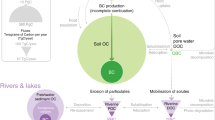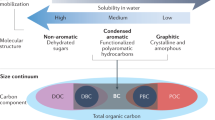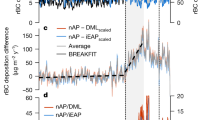Abstract
Wildfires and incomplete combustion of fossil fuel produce large amounts of black carbon. Black carbon production and transport are essential components of the carbon cycle. Constraining estimates of black carbon exported from land to ocean is critical, given ongoing changes in land use and climate, which affect fire occurrence and black carbon dynamics. Here, we present an inventory of the concentration and radiocarbon content (∆14C) of particulate black carbon for 18 rivers around the globe. We find that particulate black carbon accounts for about 15.8 ± 0.9% of river particulate organic carbon, and that fluxes of particulate black carbon co-vary with river-suspended sediment, indicating that particulate black carbon export is primarily controlled by erosion. River particulate black carbon is not exclusively from modern sources but is also aged in intermediate terrestrial carbon pools in several high-latitude rivers, with ages of up to 17,000 14C years. The flux-weighted 14C average age of particulate black carbon exported to oceans is 3,700 ± 400 14C years. We estimate that the annual global flux of particulate black carbon to the ocean is 0.017 to 0.037 Pg, accounting for 4 to 32% of the annually produced black carbon. When buried in marine sediments, particulate black carbon is sequestered to form a long-term sink for CO2.
This is a preview of subscription content, access via your institution
Access options
Access Nature and 54 other Nature Portfolio journals
Get Nature+, our best-value online-access subscription
$29.99 / 30 days
cancel any time
Subscribe to this journal
Receive 12 print issues and online access
$259.00 per year
only $21.58 per issue
Buy this article
- Purchase on Springer Link
- Instant access to full article PDF
Prices may be subject to local taxes which are calculated during checkout



Similar content being viewed by others
Change history
17 July 2018
In the HTML version of this Article originally published, Fig. 2 was incorrectly black and white; it has now been replaced with the colour version. The PDF was unaffected.
09 October 2018
In the version of this Article originally published, the units of the x and y axes in Fig. 3a were incorrectly given as ‘mg km–2 yr–1’; the correct units are ‘Mg km–2 yr–1’. These errors have now been corrected in the online versions.
References
Foster, G. L., Royer, D. L. & Lunt, D. J. Future climate forcing potentially without precedent in the last 420 million years. Nat. Commun. 8, 14845 (2017).
Zimmerman, A. R. & Mitra, S. Trial by fire: on the terminology and methods used in pyrogenic organic carbon research. Front. Earth Sci. 5, https://doi.org/10.3389/feart.2017.00095 (2017).
Santin, C. et al. Towards a global assessment of pyrogenic carbon from vegetation fires. Glob. Change Biol. 22, 76–91 (2016).
Bird, M. I., Wynn, J. G., Saiz, G., Wuster, C. M. & McBeath, A. The pyrogenic carbon cycle. Annu. Rev. Earth Planet. Sci. 43, 273–298 (2015).
Singh, N., Abiven, S., Torn, M. S. & Schmidt, M. W. I. Fire-derived organic carbon in soil turns over on a centennial scale. Biogeosciences 9, 2847–2857 (2012).
Santin, C., Doerr, S. H., Preston, C. M. & Gonzalez-Rodriguez, G. Pyrogenic organic matter production from wildfires: a missing sink in the global carbon cycle. Glob. Change Biol. 21, 1621–1633 (2015).
Lehmann, J. et al. Australian climate-carbon cycle feedback reduced by soil black carbon. Nat. Geosci. 1, 832–835 (2008).
Ascough, P. L. et al. Variability in oxidative degradation of charcoal: influence of production conditions and environmental exposure. Geochim. Cosmochim. Acta 75, 2361–2378 (2011).
Pingree, M. R. A. & DeLuca, T. H. Function of wildfire-deposited pyrogenic carbon in terrestrial ecosystems. Front. Environ. Sci. https://doi.org/10.3389/fenvs.2017.00053 (2017).
Ohlson, M., Dahlberg, B., Økland, T., Brown, K. J. & Halvorsen, R. The charcoal carbon pool in boreal forest soils. Nat. Geosci. 2, 692–695 (2009).
Aufdenkampe, A. K. et al. Riverine coupling of biogeochemical cycles between land, oceans, and atmosphere. Front. Ecol. Environ. 9, 53–60 (2011).
Battin, T. J. et al. The boundless carbon cycle. Nat. Geosci. 2, 598–600 (2009).
Raymond, P. A. et al. Global carbon dioxide emissions from inland waters. Nature 503, 355–359 (2013).
Cole, J. J. et al. Plumbing the global carbon cycle: integrating inland waters into the terrestrial carbon budget. Ecosystems 10, 171–184 (2007).
Tranvik, L. J. et al. Lakes and reservoirs as regulators of carbon cycling and climate. Limnol. Oceanogr. 54, 2298–2314 (2009).
Wang, X., Xu, C., Druffel, E. M., Xue, Y. & Qi, Y. Two black carbon pools transported by the Changjiang and Huanghe Rivers in China.Glob. Biogeochem. Cycles 30, 1778–1790 (2016).
Dittmar, T. et al. Continuous flux of dissolved black carbon from a vanished tropical forest biome. Nat. Geosci. 5, 618–622 (2012).
Jaffe, R. et al. Global charcoal mobilization from soils via dissolution and riverine transport to the oceans. Science 340, 345–347 (2013).
Coppola, A. I. & Druffel, E. R. M. Cycling of black carbon in the ocean. Geophys. Res. Lett. 43, 4477–4482 (2016).
Ziolkowski, L. A. & Druffel, E. R. M. Aged black carbon identified in marine dissolved organic carbon. Geophys. Res. Lett. 37, L16601 (2010).
Masiello, C. A. New directions in black organic chemistry. Marine Chem. 92, 201–213 (2004).
Santín, C. et al. Towards a global assessment of pyrogenic carbon from vegetation fires. Glob. Change Biol. 22, 76–91 (2015).
Guerena, D. T. et al. Terrestrial pyrogenic carbon export to fluvial ecosystems: lessons learned from the White Nile watershed of East Africa. Glob. Biogeochem. Cycles 29, 1911–1928 (2015).
Regnier, P. et al. Anthropogenic perturbation of the carbon fluxes from land to ocean. Nat. Geosci. 6, 597–607 (2013).
Vorosmarty, C. J. et al. Global threats to human water security and river biodiversity. Nature 467, 555–561 (2010).
Wheatcroft, R. A., Goni, M. A., Hatten, J. A., Pasternack, G. B. & Warrick, J. A. The role of effective discharge in the ocean delivery of particulate organic carbon by small, mountainous river systems.Limnol. Oceanogr. 55, 161–171 (2010).
Galy, V., Peucker-Ehrenbrink, B. & Eglinton, T. Global carbon export from the terrestrial biosphere controlled by erosion. Nature 521, 204–207 (2015).
Wiedemeier, D. B. et al. Characterization, quantification and compound-specific isotopic analysis of pyrogenic carbon using benzene polycarboxylic acids (BPCA). J. Vis. Exp. https://doi.org/10.3791/53922 (2016).
Myers-Pigg, A. N. et al. Labile pyrogenic dissolved organic carbon in major Siberian Arctic rivers: Implications for wildfire-stream metabolic linkages. Geophys. Res. Lett. 42, 377–385 (2015).
Lang, S. Q., Früh-Green, G. L., Bernasconi, S. M. & Wacker, L. Isotopic (δ13C, Δ14C) analysis of organic acids in marine samples using wet chemical oxidation. Limnol. Oceanogr. Methods 11, 161–175 (2013).
Reisser, M., Purves, R. S., Schmidt, M. W. I. & Abiven, S. Pyrogenic carbon in soils: A literature-based inventory and a global estimation of its content in soil organic carbon and stocks. Front. Earth Sci. https://doi.org/10.3389/feart.2016.00080 (2016).
Galy, V. & Eglinton, T. Protracted storage of biospheric carbon in the Ganges–Brahmaputra basin. Nat. Geosci. 4, 843–847 (2011).
Burdige, D. J. Preservation of organic matter in marine sediments: controls, mechanisms, and an imbalance in sediment organic carbon budgets?. Chem. Rev. 107, 467–485 (2007).
Hanke, U. M. et al. What on Earth have we been burning? Deciphering sedimentary records of pyrogenic carbon. Environ. Sci. Technol. 51, 12972–12980 (2017).
Marwick, T. R. et al. The age of river-transported carbon: a global perspective. Glob. Biogeochem. Cycles 29, 122–137 (2015).
Cotrufo, M. F. et al. Redistribution of pyrogenic carbon from hillslopes to stream corridors following a large montane wildfire.Glob. Biogeochem. Cycles 30, 1348–1355 (2016).
Frueh, W. T. & Lancaster, S. T. Correction of deposit ages for inherited ages of charcoal: implications for sediment dynamics inferred from random sampling of deposits on headwater valley floors. Quat. Sci. Rev. 88, 110–124 (2014).
Tao, S., Eglinton, T. I., Montluçon, D. B., McIntyre, C. & Zhao, M. Pre-aged soil organic carbon as a major component of the Yellow River suspended load: regional significance and global relevance. Earth. Planet. Sci. Lett. 414, 77–86 (2015).
Feng, X. et al. Differential mobilization of terrestrial carbon pools in Eurasian Arctic river basins. Proc. Natl Acad. Sci. USA 110, 14168–14173 (2013).
Schefuß, E. et al. Hydrologic control of carbon cycling and aged carbon discharge in the Congo River basin. Nat. Geosci. 9, 687–690 (2016).
Regnier, P. et al. Anthropogenic perturbation of the carbon fluxes from land to ocean. Nat. Geosci. 6, 597–607 (2013).
Marin-Spiotta, E. et al. Long-term stabilization of deep soil carbon by fire and burial during early Holocene climate change. Nat. Geosci. 7, 428–432 (2014).
Wagner, S., Cawley, K. M., Rosario-Ortiz, F. L. & Jaffe, R. In-stream sources and links between particulate and dissolved black carbon following a wildfire. Biogeochemistry 124, 145–161 (2015).
Schmidt, M. W. I. et al. Persistence of soil organic matter as an ecosystem property. Nature 478, 49–56 (2011).
Lehmann, J. et al. in Biochar for Environmental Management (eds Lehmann, J. & Joseph, S.) 235–281 (2015).
Reeburgh, W. S. Figures summarizing the global cycles of biogeochemically important elements. Bull. Ecol. Soc. Am. 78, 260–267 (1997).
Hedges, J. I. & Keil, R. G. Sedimentary organic matter preservation: an assessment and speculative synthesis. Mar. Chem. 49, 81–115 (1995).
Masiello, C. A. & Druffel, E. R. M. Black carbon in deep-sea sediments. Science 280, 1911–1913 (1998).
Ciais, P. et al. in Climate Change 2013: The Physical Science Basis (eds Stocker, T. F. et al.) Ch. 6 (IPCC, Cambridge Univ. Press, 2013).
Flannigan, M. et al. Global wildland fire season severity in the 21st century. For. Ecol. Manag. 294, 54–61 (2013).
Masiello, C. A. & Druffel, E. R. M. Carbon isotope geochemistry of the Santa Clara River. Glob. Biogeochem. Cycles 15, 407–416 (2001).
Komada, T., Druffel, E. R. M. & Trumbore, S. E. Oceanic export of relict carbon by small mountainous rivers.Geophys. Res. Lett. 31, L07504 (2004).
Glaser, B., Haumaier, L., Guggenberger, G. & Zech, W. Black carbon in soils: the use of benzenecarboxylic acids as specific markers. Org. Geochem. 29, 811–819 (1998).
Hanke, U. M. et al. Comprehensive radiocarbon analysis of benzene polycarboxylic acids (BPCAs) derived from pyrogenic carbon in environmental samples.Radiocarbon 59, 1103–1116 (2017).
Ziolkowski, L. A. & Druffel, E. R. M. The feasibility of isolation and detection of fullerenes and carbon nanotubes using the benzene polycarboxylic acid method.Marine Pollut. Bull. 59, 213–218 (2009).
Ziolkowski, L. A., Chamberlin, A. R., Greaves, J. & Druffel, E. R. M. Quantification of black carbon in marine systems using the benzene polycarboxylic acid method: a mechanistic and yield study. Limnol. Oceanogr. Methods 9, 140–149 (2011).
Hammes, K. et al. Comparison of quantification methods to measure fire-derived (black/elemental) carbon in soils and sediments using reference materials from soil, water, sediment and the atmosphere.Glob. Biogeochem. Cycles 21, GB3016 (2007).
Coppola, A. I., Ziolkowski, L. A. & Druffel, E. R. M. Extraneous carbon assessments in radiocarbon measurements of black carbon in enviromental matrices. Radiocarbon 55, 1631–1640 (2013).
Acknowledgements
We would like to thank M. Hilf for his technical support and laboratory assistance. We also are grateful for the support of D. Montlucon for collecting Mississippi River samples and locating archives, N. Drenzek for collection of the Eel River samples, A. Lima, J. King and C. Reddy for collection of Pettaquamscutt River samples, and members of the Woods Hole Research Center for collection of Colville and Yukon River samples. We thank D. Vance, B. Revels, and F. Siringan for providing the logistical foundation for collecting Amazon River and Cagayan samples, D. Brandova for her technical assistance, and the ETH Ion Beam Physics Lab AMS Lab colleagues for AMS support. We thank N. Baltensweiler (University of Zurich, Information Technology MELS/SIVIC) and G. J. Fiske (Woods Hole Research Center) for help with Figs 1 and 3, respectively. We thank I. Medhaug for comments on the manuscript. A.C. acknowledges financial support from the University of Zurich Forschungskredit Fellowship and the University of Zurich (grant No. STWF-18-026). M.R., S.A. and M.S. acknowledge support from the University Research Priority Projection Global Change and Biodiversity (URPP-GCB). M.Z. acknowledges support from the National Natural Science Foundation of China (No. 41521064). T.E. acknowledges support from the Swiss National Science Foundation (“CAPS-LOCK” and “CAPS-LOCK2” #200021_140850). V.G. acknowledges financial support from an Independent Study Award from the Woods Hole Oceanographic Institution.
Author information
Authors and Affiliations
Contributions
D.W., T.E., M.S. and A.C. contributed to the design of the study. T.E., G.N, M.U., T.B., C.F., E.S., M.Z., B.V., V.G., M.R. and B.P.E. provided river samples. A.C. and D.W. conducted the black carbon laboratory analyses. N.H., A.C., U.H. and L.W. provided analytical assistance and quality control to the radiocarbon measurements. V.G., A.C., S.A, M.S., E.S. and T.E. contributed to data analysis and interpretation. A.C. authored the manuscript and constructed the figures. All authors contributed comments and input on this manuscript.
Corresponding author
Ethics declarations
Competing interests
The authors declare no competing interests.
Additional information
Publisher’s note: Springer Nature remains neutral with regard to jurisdictional claims in published maps and institutional affiliations.
Supplementary information
Supplementary Information
Supplementary Description, Figures and Tables.
Rights and permissions
About this article
Cite this article
Coppola, A.I., Wiedemeier, D.B., Galy, V. et al. Global-scale evidence for the refractory nature of riverine black carbon. Nature Geosci 11, 584–588 (2018). https://doi.org/10.1038/s41561-018-0159-8
Received:
Accepted:
Published:
Issue Date:
DOI: https://doi.org/10.1038/s41561-018-0159-8
This article is cited by
-
Millennial-aged pyrogenic carbon in high-latitude mineral soils
Communications Earth & Environment (2024)
-
Oxygen-limited pyrolysis and incineration impact on biochar transport
Environmental Science and Pollution Research (2023)
-
Isotopic evidence for sources of dissolved carbon and the role of organic matter respiration in the Fraser River basin, Canada
Biogeochemistry (2023)
-
Pyrogenic carbon decomposition critical to resolving fire’s role in the Earth system
Nature Geoscience (2022)
-
Fate of dissolved black carbon in the deep Pacific Ocean
Nature Communications (2022)



